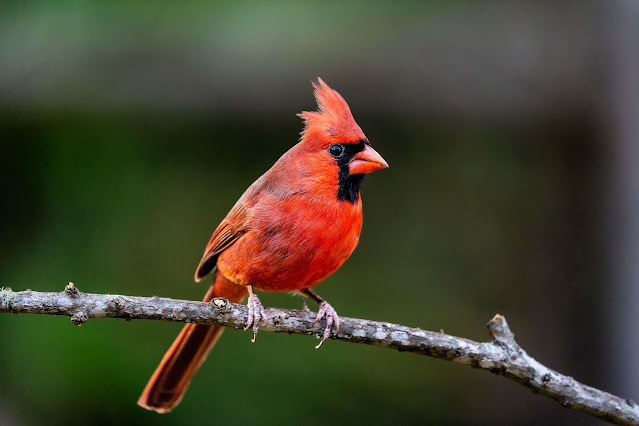Ah, the Northern Cardinal (Cardinalis cardinalis), a delightful visitor to
gardens across North America, including your charming corner in Prince Edward
Island. These vibrant birds, with their striking red plumage and distinctive
crest, never fail to bring joy to any landscape.
Imagine stepping into your garden and being greeted by cheerful chirps and flashes of red as these cardinals flit about. Their
presence is not just a visual delight but also an auditory one, as their
melodic songs add a beautiful soundtrack to your outdoor haven.
Now, let's delve into some fascinating tidbits about these
charismatic birds. Did you know that the male Northern Cardinal is not just a
handsome sight but also a devoted partner? During courtship, he brings food to
the female as a gesture of affection. It's heartwarming to witness such
displays of avian romance right in your own backyard.
Cardinals aren't just charming; they also play a crucial
role in controlling insect populations. With their voracious appetite for
insects and seeds, they contribute to the ecological balance of your garden.
It's like having nature's pest control squad right at your doorstep.
And speaking of doorstep, the Northern Cardinal isn't just a
summer visitor. These resilient birds stick around during the colder months,
adding a burst of color to your winter landscape. Imagine the contrast of their
crimson feathers against a backdrop of snow – truly a picturesque scene.
So, as you sip your warm coffee and gaze out into your
garden, take a moment to appreciate the avian wonders around you. The Northern
Cardinal, with its vibrant hues and lively presence, is a testament to the
beauty and diversity that can thrive in even the coziest corners of Prince
Edward Island.
Here's to the simple joys of a garden filled with life, where each fluttering wing tells a story of nature's intricate dance. Cheers to the Northern Cardinal and the vibrant tapestry they contribute to your peaceful haven!
Frequently asked questions:
Where are northern cardinals most common?
These striking birds are most commonly found in the eastern
and central parts of North America, so you're in luck with their frequent
presence in your area.
What are the characteristics of the Northern Cardinal?
Male Northern Cardinals boast brilliant red feathers and a
distinctive crest, while females flaunt a more subdued combination of tan and
red. Both genders share a charming personality and enchanting melodic calls.
Why are cardinals so special?
Cardinals are special for various reasons, from their
vibrant appearance and beautiful songs to their beneficial role in controlling
insect populations. Their year-round presence adds a touch of magic to gardens
across Canada.
What bird is only found in Canada?
While Northern Cardinals are not exclusive to Canada, they
are a captivating and common bird in the country. The Gray Jay, also known as
the Canada Jay, is a bird species found only in Canada.
What is the lifespan of a northern cardinal?
Northern Cardinals typically have a lifespan of 3-5 years,
although some individuals may live longer in optimal conditions.
Are cardinals aggressive to other birds?
Male cardinals can be territorial and may display aggression
towards other males during the breeding season. They are less aggressive
towards other bird species.
How do you attract Northern Cardinals?
To attract these charming birds, provide a mix of seeds,
especially sunflower seeds, and offer a reliable water source. Dense shrubs and
trees in your garden can also create a welcoming environment.
Where do Canadian cardinals go in the winter?
While some may stay in Canada, others might migrate
southward in search of milder winter conditions. Your garden might still be
graced by their presence during the colder months.
Do cardinals mate for life?
Yes, Northern Cardinals are known for forming monogamous
pairs, and many choose to stay with the same mate for life.
Do blue jays and cardinals get along?
While they may have some territorial disputes, Blue Jays and
Cardinals generally coexist peacefully in shared spaces. Providing ample food
sources can help reduce potential conflicts.

